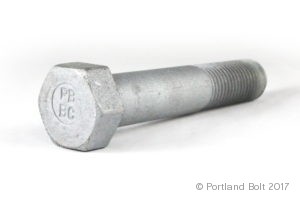 There are no issues with hot-dip galvanizing A354 Grade BC material, however there are significant concerns regarding galvanizing A354 Grade BD. Because Grade BD has a minimum tensile strength of 150 ksi, galvanizing it presents the risk of hydrogen embrittlement.
There are no issues with hot-dip galvanizing A354 Grade BC material, however there are significant concerns regarding galvanizing A354 Grade BD. Because Grade BD has a minimum tensile strength of 150 ksi, galvanizing it presents the risk of hydrogen embrittlement.
Hydrogen embrittlement may occur when atomic hydrogen is absorbed by the steel during the acid pickling process that takes place prior to galvanizing. This embrittlement can potentially lead to the loss or partial loss of ductility in the steel and consequently result in the premature failure of the material in the field.
Several ASTM specifications make note of this issue.
Note 4 in ASTM A354 states:
“Research conducted on bolts of similar material and manufacture indicates that hydrogen-stress cracking or stress cracking corrosion may occur on hot-dip galvanized Grade BD bolts.”
From ASTM A143 – Safeguarding Against Embrittlement of Hot-Dip Galvanized Structural Steel Products and Procedure for Detecting Embrittlement :
“In practice hydrogen embrittlement of galvanized steel is usually of concern only if the steel exceeds approximately 150 ksi (1100 MPa) in ultimate tensile strength.”
Section 7.2.2 of specification ASTM F2329 – Zinc Coating, Hot-Dip, Requirements for Application to Carbon and Alloy Steel Bolts, Screws, Washers, Nuts, and Special Threaded Fasteners also addresses this issue:
“For high strength fasteners (having a specified minimum product hardness of 33 HRC), there is a risk of internal hydrogen embrittlement.”
